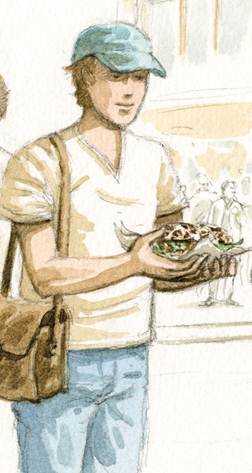Gustain

Gustain, reporter taste-pain, en pleine dégustation d’un sandwich à base de Dutch Crunch (ou Tijgerbrood) à San Francisco.
Le voyage de Gustain du Maroc à la Russie
Nous pensons souvent connaître intimement l’univers du pain parce qu’il nous accompagne chaque jour. Les Français s’imaginent même en être les inventeurs. Pourtant un simple regard sur nos livres d’histoire, une excursion à travers les pays des « mangeurs de pain » – l’expression est chez Homère parlant des Grecs –, nous prouve que le pain est en partage. Il est le marqueur de la civilisation des agriculteurs, et chaque peuple l’a fait sien.
Comme le découvre Gustain, jeune reporter taste-pain à travers les pays qui ont enrichi cette longue histoire, les peuples ont développé partout sur la terre leurs propres recettes, leur symbolique, leur mythologie, leurs rituels autour de cet objet identitaire par excellence. Comment trouver en effet un objet plus familier que le pain qui dirait avec plus de vérité ce que sont les Indiens, les Mexicains, les Géorgiens, les Egyptiens, les Péruviens, les Français, les Irakiens et jusqu’aux peuples de l’Asie qui, comme on va le voir, ne l’ont pas ignoré ?
La différence se fait au niveau des céréales utilisées, voire des racines ou tubercules, des modes de fermentation, de cuisson, des symboles que chaque pain véhicule, des pratiques alimentaires et ce Tour du Monde en 80 pains choisis dans 80 pays différents va nous révéler toute la richesse de cette palette boulangère proprement inouïe. La difficulté pour Gustain a été, pour chaque pays visité, de choisir UN pain et un seul, car telle était la règle du jeu. Un pain parmi une infinité de formes, de saveurs, de recettes gageant de l’inventivité des hommes et de leur génie.
80 pains, pour 80 pays, ambassadeurs d’une longue Odyssée commune qui commence en Mésopotamie il y a quelque 10 000 ans. Les routes des pains partent ainsi de ce qu’est l’Irak actuel pour parcourir tous les continents. Sous le crayon de Jean-François Barbier, sous la plume de Jean-Philippe de Tonnac, Gustain s’est révélé être un voyageur infatigable.
Jeune montagnard âgé de 15 ans, j’ai un jour poussé la porte d’une boulangerie pour me faire un peu d’argent de poche. J’ignorais alors que cette porte donnait accès à un univers auquel j’allais consacrer toute mon énergie d’homme et d’entrepreneur. Si le pain permet de retracer l’histoire commune des premiers agriculteurs et de leurs descendants, il raconte aussi une Alliance à mes yeux sacrée : celle de l’Agriculteur condamné à composer avec les caprices de la nature, les versatilités du ciel, les injonctions des politiques ; du Meunier passionné de son métier et travailleur infatigable ; du Boulanger qui doit conduire le pain qui résultera de fermentations et de cuissons bien menées, à son degré d’exaltation.
J’ai donc créé ma société Eurogerm dans le souci de servir cette Alliance sacrée, de la remettre au cœur de l’activité meunière et boulangère que nous épaulons et soutenons depuis 1989 et que nous savons appelée à se déployer sans cesse en qualité. Ce Tour du Monde en 80 pains traduit à sa manière notre approche internationale du métier : présent sur les cinq continents, nous avons dû apprendre à prononcer le mot « pain » dans toutes les langues. C’est cette richesse et cette diversité que nos équipes servent avec passion. Elles sont les ingrédients essentiels de ce Tour du Monde de la boulangerie que nous vous proposons. C’est cette richesse que je souhaitais vous faire partager.
Bon voyage !
Jean-Philippe Girard
P.-D.G. d’Eurogerm
